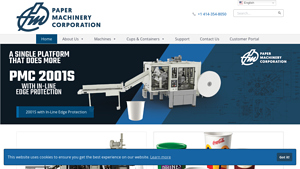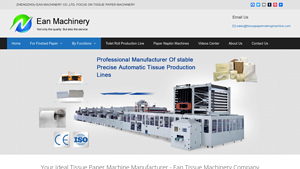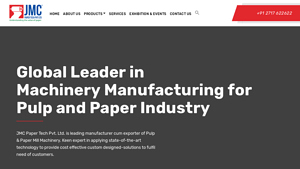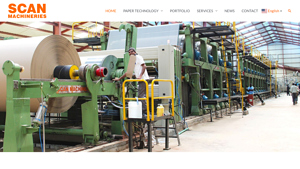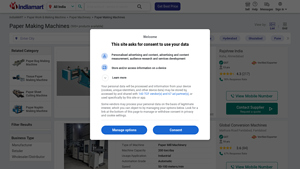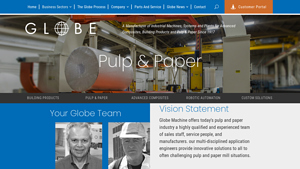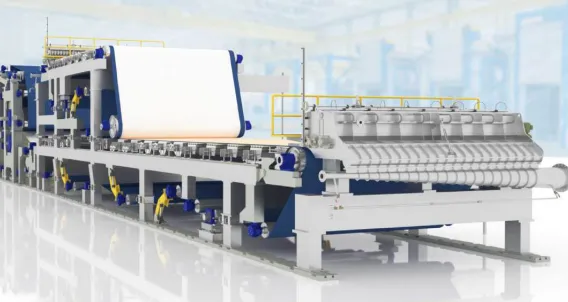Top 8 Paper Machine Manufacturers List and Guide: How To Solve Sc…
Introduction: Navigating the Global Market for Paper Machine Manufacturers
In the rapidly evolving landscape of the paper industry, sourcing high-quality paper machines is a critical challenge for international B2B buyers. As production demands increase and sustainability concerns rise, manufacturers must navigate a complex global market filled with diverse options, from advanced papermaking technologies to efficient rebuilding solutions. This guide aims to equip buyers with the insights necessary to make informed decisions about paper machine manufacturers, focusing on essential factors such as types of machinery, applications, supplier vetting processes, and cost considerations.
Throughout this comprehensive guide, we will delve into the various categories of paper machines, including those for papermaking, cutting, and packaging, while addressing the specific needs of buyers across Africa, South America, the Middle East, and Europe, including regions like Saudi Arabia and Vietnam. We will explore the reputation and technological prowess of top manufacturers, highlighting their capabilities in innovation, customization, and after-sales support. By providing actionable insights and strategic recommendations, this guide empowers B2B buyers to confidently select the right partners in the global market, ensuring enhanced production efficiency and long-term operational success. Whether you are looking to invest in new machinery or considering upgrades to existing lines, our expert analysis will serve as a valuable resource in navigating your purchasing journey.
Top 10 Paper Machine Manufacturers Manufacturers & Suppliers List
1. Valmet – Board and Paper Machine Technology
Domain: valmet.com
Registered: 1991 (34 years)
Introduction: Valmet offers proven technology for board and paper machines, including new lines and rebuilds. Key components include headbox, forming, pressing, cylinder drying, impingement drying, process ventilation, sizing, coating, coating drying, calendering, reeling, and parent roll handling. Valmet also provides pilot trials for paper and board grades, project execution, and various services such as proc…
2. Voith – Papermaking Solutions
Domain: voith.com
Registered: 1996 (29 years)
Introduction: Voith Paper offers a range of solutions for papermaking, including XcelLine paper machines designed for efficient production of any paper grade, stock preparation concepts, and sustainable water management solutions through AquaLine. They provide over 130,000 different spare parts, advanced services, and digital solutions under the Papermaking 4.0 portfolio. Their offerings also include customized…
3. PaperMC – Premier Cup Forming Machinery
Domain: papermc.com
Registered: 1995 (30 years)
Introduction: The World’s Leading Paper Cup Forming Machinery includes various models such as: PMC 1300 Series Container Forming Machine, PMC 1003 Cup/Container Forming Machine, PMC 2500S Servo Driven Cup/Container Forming Machine, PMC 2001S Servo Driven Forming Machine, PMC 2001S with In-Line Edge Protection, PMC 1003P Plastic Cup/Container Forming Machine, PMC 2500SP Servo Driven Plastic Cup/Container Forming…
4. Ean Machinery – Tissue Paper Making Machines
Domain: tissuepapermakingmachine.com
Registered: 2017 (8 years)
Introduction: Ean Machinery offers a variety of tissue paper making machines for sale, including: Toilet Paper Machine, Facial Tissue Machines, Paper Napkin Machine, Paper Towel Machine, Non-woven Towel Machine, Coffee Filter Bag Machine, and A4 Paper Making Machine. They provide complete production lines for different tissue products, including toilet paper rolls, kitchen towels, facial tissues, hand towels, a…
5. JMC Papertech – Pulp and Paper Machinery
Domain: jmcmachines.com
Registered: 2006 (19 years)
Introduction: JMC Papertech Pvt. Ltd. manufactures and exports a variety of pulp and paper machinery, including:
– Pulp Mill (Agro Based and Wood Based)
– Stock Preparation
– Recycled OCC, DSOCC, White Waste, and Mix Waste Paper Machines
– Industrial Paper Machines (Kraft Paper, Duplex Board, Cultural Paper, Writing & Printing Paper, Newsprint Paper, Specialty Paper, Tissue Paper)
– Coating Machines (Onlin…
6. Scan Machineries – Complete Paper Machine Lines
7. Indiamart – Paper Making Machines
8. Globe Machine – Custom Systems for Pulp and Paper Industry
Domain: globemachine.com
Registered: 1996 (29 years)
Introduction: Globe Machine offers a range of custom systems and solutions for the pulp and paper industry, including:
1. **Pulp Mills:**
– **Pulp Bale De-Wiring and Pulper Feed Systems:** Custom systems for bale de-wiring, de-stacking, wire coiling, stray wire detection, and more, designed for high efficiency in feeding pulpers.
– **Pulp Bale and Roll Finishing Systems:** Complete systems for kraft o…
Understanding Paper Machine Manufacturers Types and Variations
| Type Name | Key Distinguishing Features | Primary B2B Applications | Brief Pros & Cons for Buyers |
|---|---|---|---|
| Full-Line Manufacturers | Offer comprehensive solutions covering all aspects of papermaking | Large-scale paper production | Pros: One-stop shop; Cons: Higher initial investment |
| Specialized Equipment Suppliers | Focus on specific machines or processes, such as pulping or coating | Niche applications or upgrades | Pros: Tailored solutions; Cons: Limited scope of services |
| Rebuild and Retrofit Providers | Expertise in upgrading existing machines for improved efficiency | Cost-effective modernization | Pros: Enhanced performance; Cons: Potential downtime |
| Automation and Control Specialists | Provide advanced technology for process automation and monitoring | Efficiency optimization | Pros: Increased productivity; Cons: Complexity in integration |
| Custom Machine Builders | Design and manufacture machines based on unique customer specifications | Specialized production needs | Pros: Highly tailored solutions; Cons: Longer lead times |
What are the Characteristics of Full-Line Manufacturers in the Paper Industry?
Full-line manufacturers, such as Valmet and Voith, provide a complete suite of machinery and services for all stages of paper production. This includes everything from stock preparation to finishing processes. Their holistic approach is beneficial for companies looking to streamline operations and ensure compatibility across equipment. Buyers should consider their overall production goals and whether a full-line solution aligns with their operational strategies, as these options often come with a higher initial investment but provide long-term efficiency gains.
Why Choose Specialized Equipment Suppliers for Niche Applications?
Specialized equipment suppliers focus on specific areas of the paper manufacturing process, such as pulping, coating, or cutting. Companies like ANDRITZ offer tailored machinery that can significantly enhance particular aspects of production. This is ideal for businesses looking to upgrade specific processes without overhauling their entire production line. When selecting a specialized supplier, buyers should evaluate their specific operational needs and the potential for improved performance in targeted areas.
How Can Rebuild and Retrofit Providers Enhance Existing Operations?
Rebuild and retrofit providers offer solutions to enhance the efficiency and capability of existing paper machines. By focusing on modernization, they help companies reduce costs and improve production without the need for a complete replacement. This option is particularly attractive for businesses with older equipment that still has potential. Buyers should consider the potential downtime and the costs associated with retrofitting compared to investing in new machinery.
What Role Do Automation and Control Specialists Play in Paper Production?
Automation and control specialists provide advanced technologies that optimize the efficiency of paper production processes. With a focus on integrating digital solutions for monitoring and control, these providers can significantly boost productivity. Companies looking to implement smart manufacturing practices will find value in these solutions. However, buyers must assess the complexity of integrating these systems with their existing operations and ensure they have the necessary support for implementation.
Why Consider Custom Machine Builders for Unique Production Needs?
Custom machine builders design and manufacture equipment based on specific customer requirements, making them suitable for businesses with unique production needs. This tailored approach allows for the creation of highly specialized machinery that can address particular challenges or production goals. However, buyers should be aware that custom solutions often involve longer lead times and higher costs. It’s essential to weigh the benefits of customization against the time and financial investment required.
Key Industrial Applications of Paper Machine Manufacturers
| Industry/Sector | Specific Application of Paper Machine Manufacturers | Value/Benefit for the Business | Key Sourcing Considerations for this Application |
|---|---|---|---|
| Packaging Industry | Production of corrugated cardboard and paperboard | Enhanced durability and protection for products | Machine flexibility for various grades and sustainable materials |
| Printing Industry | High-quality printing paper production | Improved print quality and color fidelity | Precision in machine setup and compatibility with inks |
| Tissue and Hygiene Products | Manufacturing of tissue paper products | Increased absorbency and softness | Efficiency in production to meet high demand and sustainability |
| Specialty Papers | Production of coated and uncoated specialty papers | Customization for niche applications | Advanced technology for coating and drying processes |
| Recycled Paper Production | Processing of recycled fibers into new paper | Cost savings and reduced environmental impact | Reliability in handling varying qualities of recycled materials |
How Are Paper Machine Manufacturers Applied in Key Industries?
What Role Do Paper Machine Manufacturers Play in the Packaging Industry?
In the packaging industry, paper machine manufacturers supply equipment specifically designed for producing corrugated cardboard and paperboard. These machines are engineered to enhance the durability of packaging materials, ensuring they can withstand transportation and handling. Buyers in this sector need machines that offer flexibility to accommodate various grades of paper and sustainable materials to meet increasing environmental regulations. Efficient production capabilities also play a crucial role in minimizing costs while maximizing output.
How Are Paper Machine Manufacturers Transforming the Printing Industry?
For the printing industry, paper machine manufacturers provide advanced machinery that produces high-quality printing paper. This is essential for achieving superior print quality and color fidelity, which are critical for customer satisfaction. Buyers must consider the precision of machine setups and their compatibility with various types of inks to ensure optimal results. Additionally, the ability to customize paper specifications to meet specific printing requirements is a significant advantage.
What Are the Applications of Paper Machine Manufacturers in Tissue and Hygiene Products?
In the production of tissue and hygiene products, paper machine manufacturers offer specialized machines that enhance absorbency and softness. These machines are designed to handle large volumes efficiently, addressing the high demand for tissue products in both consumer and commercial markets. Buyers should prioritize sourcing machines that ensure operational efficiency and sustainability, particularly as consumer preferences shift towards eco-friendly products.
How Do Paper Machine Manufacturers Cater to Specialty Paper Needs?
Specialty papers, which include coated and uncoated varieties, require specific technologies for production. Paper machine manufacturers provide tailored solutions that allow for customization based on niche applications, such as food packaging or artistic uses. Buyers should focus on advanced coating and drying technologies to meet the diverse needs of their end-users. The ability to adapt to varying production requirements is essential for maximizing profitability in this sector.
How Are Paper Machine Manufacturers Supporting Recycled Paper Production?
In the realm of recycled paper production, paper machine manufacturers facilitate the processing of recycled fibers into new paper products. This application not only leads to significant cost savings but also aligns with global sustainability goals. Buyers in this sector must consider the reliability of machinery in handling different qualities of recycled materials, as well as the efficiency of the production process. The ability to produce high-quality paper from recycled sources is increasingly important in today’s environmentally-conscious market.
3 Common User Pain Points for ‘Paper Machine Manufacturers’ & Their Solutions
Scenario 1: Navigating High Downtime Due to Machinery Malfunction
The Problem: B2B buyers in the paper manufacturing industry often face significant challenges when their machinery experiences unexpected downtime. This not only disrupts production schedules but also leads to financial losses and missed deadlines. The intricacies of paper machines mean that when one component fails, it can halt the entire production line, causing delays in fulfilling customer orders and a potential loss of market competitiveness. This scenario is particularly acute for manufacturers operating in regions with limited access to quick maintenance services or spare parts.
The Solution: To mitigate this risk, buyers should prioritize selecting paper machine manufacturers that offer robust after-sales support, including comprehensive maintenance packages and readily available spare parts. Engaging with manufacturers who provide predictive maintenance solutions can also be advantageous. These services utilize advanced analytics to foresee potential failures before they occur, allowing for timely interventions. When discussing contracts, buyers should ensure that service level agreements (SLAs) include guaranteed response times for maintenance and a clear inventory of critical spare parts to minimize downtime. Additionally, forming a close partnership with the manufacturer can enhance communication and improve support during emergencies, ensuring that the production line can resume swiftly and efficiently.
Scenario 2: Struggling with Energy Efficiency and Operational Costs
The Problem: As energy costs continue to rise globally, many paper manufacturers find themselves grappling with high operational expenses, particularly in energy-intensive processes like drying and pulping. This issue is exacerbated in regions like Africa and South America, where energy infrastructure may be less reliable. For B2B buyers, the challenge lies in balancing production efficiency with sustainability, as consumers increasingly demand environmentally friendly practices.
The Solution: Buyers should seek out paper machine manufacturers that specialize in energy-efficient technology and sustainable practices. Engaging with companies that offer modern, fit-for-purpose machines designed for lower energy consumption can lead to significant cost savings. When evaluating potential suppliers, buyers should request detailed information about the energy performance of the machines, including energy consumption metrics and lifecycle analysis. Additionally, investing in automation and control systems that optimize energy use during production can further enhance efficiency. Buyers should also explore financing options such as energy performance contracts, which can alleviate upfront costs and allow for the gradual recovery of investment through energy savings.
Scenario 3: Difficulty in Customizing Machinery for Diverse Product Lines
The Problem: Manufacturers often need to adapt their production lines to meet varying customer demands for different paper grades and formats. This customization can be particularly challenging for B2B buyers who might be limited by the capabilities of their existing machinery. As market demands shift, the inability to efficiently produce diverse products can lead to lost business opportunities and an inability to compete effectively in the marketplace.
The Solution: To address this challenge, B2B buyers should partner with paper machine manufacturers that offer modular and flexible machinery solutions. These machines should be capable of quick adjustments and modifications to accommodate different paper grades without extensive downtime. When sourcing machinery, buyers should focus on manufacturers known for their innovative designs that allow for easy upgrades and retrofits. Additionally, it’s crucial to engage in thorough discussions about customization capabilities during the procurement process, ensuring that the chosen machinery aligns with the anticipated product portfolio. Regular training and support from the manufacturer can also empower operators to make necessary adjustments quickly, enhancing production flexibility and responsiveness to market changes.
Strategic Material Selection Guide for Paper Machine Manufacturers
What Are the Key Materials Used in Paper Machine Manufacturing?
In the manufacturing of paper machines, selecting the right materials is crucial for optimizing performance, durability, and cost-effectiveness. Below, we analyze four common materials used in this industry, focusing on their properties, advantages, disadvantages, and specific considerations for international buyers.
How Does Stainless Steel Benefit Paper Machine Manufacturing?
Key Properties: Stainless steel is renowned for its excellent corrosion resistance, high strength, and ability to withstand high temperatures and pressures. This makes it ideal for components that come into contact with water, steam, and chemicals used in the papermaking process.
Pros & Cons: The durability of stainless steel ensures a long lifespan, reducing the need for frequent replacements. However, it is more expensive than other materials, which can impact initial investment costs. Additionally, manufacturing processes involving stainless steel can be complex due to its hardness, requiring specialized equipment.
Impact on Application: Stainless steel is particularly suitable for components like the headbox, press sections, and drying cylinders, where media compatibility with water and chemicals is essential.
Considerations for International Buyers: Buyers from regions like Africa and the Middle East should ensure compliance with local standards, such as ASTM or DIN. The availability of stainless steel can vary, so sourcing from local suppliers may help mitigate shipping costs.
What Role Does Carbon Steel Play in Paper Machine Manufacturing?
Key Properties: Carbon steel is characterized by its high tensile strength and affordability. While it lacks the corrosion resistance of stainless steel, it can be treated with coatings to enhance its durability.
Pros & Cons: The primary advantage of carbon steel is its lower cost, making it attractive for budget-conscious projects. However, its susceptibility to rust and corrosion can lead to shorter lifespans and increased maintenance needs, especially in humid environments.
Impact on Application: Carbon steel is commonly used for structural components and frames, where high strength is required, but exposure to corrosive environments is limited.
Considerations for International Buyers: Buyers in South America and Europe should be aware of the need for protective coatings and treatments to extend the life of carbon steel components. Compliance with local standards for treated materials is also essential.
Why Is Composite Material Increasingly Popular in Paper Machine Manufacturing?
Key Properties: Composites, often made from a combination of materials like fiberglass and resins, offer lightweight properties and excellent resistance to corrosion and chemical exposure.
Pros & Cons: The lightweight nature of composites can lead to reduced energy consumption during operation. However, they can be more expensive to manufacture and may require specialized fabrication techniques.
Impact on Application: Composites are ideal for applications where weight reduction is critical, such as in certain drying sections and conveyor systems.
Considerations for International Buyers: Buyers in regions with stringent environmental regulations, such as Europe, may prefer composites due to their lower environmental impact compared to traditional materials. Understanding local regulations on composite materials is crucial.
How Does Rubber Contribute to Paper Machine Efficiency?
Key Properties: Rubber is known for its excellent elasticity, vibration dampening, and resistance to wear. It can handle varying temperatures and is often used in applications requiring flexibility.
Pros & Cons: The primary advantage of rubber is its ability to absorb shocks and vibrations, enhancing the longevity of machinery components. However, its lifespan can be limited in high-temperature environments, and it may require regular replacement.
Impact on Application: Rubber is commonly used in rolls, seals, and gaskets, where flexibility and wear resistance are necessary.
Considerations for International Buyers: Buyers from regions like Saudi Arabia and Vietnam should consider the local climate and temperature variations when selecting rubber materials. Ensuring compliance with local standards for rubber quality is also important.
Summary Table of Material Selection for Paper Machine Manufacturers
| Material | Typical Use Case for Paper Machine Manufacturers | Key Advantage | Key Disadvantage/Limitation | Relative Cost (Low/Med/High) |
|---|---|---|---|---|
| Stainless Steel | Headbox, press sections, drying cylinders | Excellent corrosion resistance | Higher initial cost | High |
| Carbon Steel | Structural components, frames | Cost-effective | Susceptible to rust | Low |
| Composite | Drying sections, conveyor systems | Lightweight, corrosion-resistant | Higher manufacturing costs | Medium |
| Rubber | Rolls, seals, gaskets | Shock absorption, flexibility | Limited lifespan in high temps | Medium |
This strategic material selection guide aims to equip international B2B buyers with the insights necessary to make informed decisions when sourcing materials for paper machine manufacturing. Understanding the properties, advantages, and regional considerations of each material will facilitate more effective procurement strategies.
In-depth Look: Manufacturing Processes and Quality Assurance for Paper Machine Manufacturers
What Are the Main Stages of Manufacturing for Paper Machine Manufacturers?
The manufacturing process for paper machines is a complex endeavor that consists of several critical stages. Understanding these stages can help B2B buyers make informed decisions when selecting a supplier.
1. Material Preparation
The first step in manufacturing paper machines involves the preparation of raw materials. This includes selecting high-quality steel and other components necessary for the machine’s construction. Suppliers often utilize advanced cutting and shaping technologies, such as laser cutting and CNC machining, to ensure precision.
Material preparation also encompasses the sourcing of specialized components like rolls, frames, and drying sections, which must meet specific durability and performance standards. Buyers should verify that suppliers have reliable sources for these materials, as it directly impacts the machine’s longevity and efficiency.
2. Forming
During the forming stage, the prepared materials are assembled into functional components of the paper machine. This includes the construction of key sections like the headbox, forming fabric, and press section. Techniques such as welding, riveting, and bolting are commonly employed to ensure structural integrity.
The forming process is often a collaborative effort between engineers and skilled technicians. This collaboration is crucial for adhering to design specifications and performance standards. Buyers should inquire about the expertise of the workforce involved in this stage, as it significantly affects the overall quality of the machine.
3. Assembly
Once the individual components are fabricated, they are assembled into a complete paper machine. This stage requires meticulous attention to detail to ensure that all parts fit correctly and function seamlessly. Automated assembly lines are increasingly common, enhancing efficiency and reducing the likelihood of human error.
Quality assurance checkpoints are integrated into the assembly process. These checkpoints help identify any discrepancies early, ensuring that the final product meets the required specifications. B2B buyers should ask potential suppliers about their assembly techniques and the experience level of their technicians.
4. Finishing
The finishing stage includes a series of processes designed to enhance the machine’s performance and aesthetics. This may involve surface treatments, painting, and coating to protect against corrosion and wear. Additionally, final adjustments are made to optimize the machine’s efficiency and functionality.
At this point, manufacturers conduct initial tests to ensure that all systems are operational. B2B buyers should request details about the finishing techniques employed, as well as any certifications related to environmental and safety standards.
How Is Quality Assurance Integrated into the Manufacturing Process?
Quality assurance is a fundamental aspect of manufacturing paper machines. Adhering to international standards is critical for ensuring product reliability and customer satisfaction.
What Are the Relevant International Standards for Quality Assurance?
Key international standards that paper machine manufacturers often comply with include ISO 9001, which focuses on quality management systems, and CE marking, which signifies that products meet EU safety and health requirements. Additionally, industry-specific standards, such as API (American Petroleum Institute) for certain components, may also apply.
B2B buyers should ensure that their suppliers possess the necessary certifications and regularly update their compliance with these standards. This can be done through documentation requests or by checking the supplier’s website for certifications.
What Are the Key Quality Control Checkpoints in the Manufacturing Process?
Quality control (QC) is integrated throughout the manufacturing process, with several checkpoints established to monitor quality at various stages:
-
Incoming Quality Control (IQC): This initial checkpoint assesses the quality of raw materials and components before they enter the manufacturing process. It ensures that only high-quality materials are used, which is vital for the machine’s durability.
-
In-Process Quality Control (IPQC): Throughout the manufacturing stages, continuous monitoring is performed to detect any deviations from quality standards. This includes checking the accuracy of assembly and ensuring that all components function as intended.
-
Final Quality Control (FQC): Once the machine is fully assembled, a comprehensive testing phase occurs. This involves operational tests to verify that the machine meets all performance criteria, including speed, efficiency, and safety.
What Common Testing Methods Are Used in Quality Assurance?
Manufacturers employ various testing methods to validate the quality of paper machines. These methods include:
- Functional Testing: Ensures that all machine components operate correctly under simulated working conditions.
- Performance Testing: Assesses the machine’s efficiency and output compared to design specifications.
- Stress Testing: Evaluates the machine’s durability by subjecting it to extreme operational conditions.
B2B buyers should inquire about the specific testing protocols used by manufacturers, as these tests provide insight into the reliability and longevity of the machinery.
How Can B2B Buyers Verify Supplier Quality Control?
To ensure that a supplier maintains high-quality standards, B2B buyers can take several proactive steps:
-
Conduct Supplier Audits: Regular audits allow buyers to assess a supplier’s manufacturing processes, quality control measures, and compliance with international standards.
-
Request Quality Reports: Buyers should ask for detailed reports on quality control tests, including any issues encountered and resolutions implemented.
-
Engage Third-Party Inspectors: Utilizing independent inspection services can provide an unbiased evaluation of a supplier’s quality assurance processes.
What Are the Quality Control Nuances for International B2B Buyers?
For international buyers, particularly those from regions like Africa, South America, the Middle East, and Europe, understanding local regulations and standards is crucial. Different regions may have specific compliance requirements that manufacturers must adhere to, influencing the quality assurance processes.
Furthermore, cultural differences in business practices can affect communication and expectations regarding quality. Buyers should establish clear agreements on quality standards and performance metrics to avoid misunderstandings.
By thoroughly understanding the manufacturing processes and quality assurance measures employed by paper machine manufacturers, B2B buyers can make informed decisions that ultimately lead to successful procurement and operational efficiency.
Practical Sourcing Guide: A Step-by-Step Checklist for ‘Paper Machine Manufacturers’
In the competitive landscape of paper manufacturing, selecting the right paper machine manufacturer is crucial for operational efficiency and product quality. This guide provides a structured approach to help international B2B buyers effectively source paper machine manufacturers that align with their specific needs and objectives.
Step 1: Define Your Technical Specifications
Understanding your technical requirements is the first step in the sourcing process. Clearly outline the types of paper machines you need, such as papermaking machines, cutting machines, or packaging machines. This clarity will help you communicate your needs effectively to potential suppliers and ensure they can meet your production goals.
Step 2: Research Potential Manufacturers
Conduct thorough research to compile a list of potential manufacturers. Look for companies with a strong reputation in the industry, such as Valmet and Voith, which are known for their innovative solutions and global presence. Utilize online resources, industry publications, and trade shows to gather insights about their capabilities and market standing.
Step 3: Evaluate Supplier Experience and Expertise
Assess the experience and technological expertise of each manufacturer. Companies with a long history in the industry typically have a wealth of knowledge that can be beneficial for your operations. Ask for case studies or examples of similar projects they have completed successfully to gauge their proficiency.
Step 4: Check References and Reviews
Before making a decision, it is essential to check references and customer reviews. Reach out to other businesses in your industry that have worked with the manufacturers you are considering. This feedback can provide valuable insights into the reliability and performance of the machines, as well as the level of customer service you can expect.
Step 5: Request Proposals and Quotations
Once you have shortlisted potential manufacturers, request detailed proposals and quotations. Ensure that these documents outline the specifications, pricing, delivery timelines, and terms of service. Comparing multiple proposals can help you identify the best value for your investment while also ensuring that all your requirements are met.
Step 6: Assess After-Sales Support and Maintenance Services
After-sales support is a critical factor that can significantly impact your production efficiency. Inquire about the maintenance services, spare parts availability, and training programs offered by the manufacturers. A manufacturer that provides robust support will help you minimize downtime and enhance the longevity of your machines.
Step 7: Verify Compliance and Certifications
Lastly, ensure that the manufacturers comply with international standards and possess the necessary certifications. This verification not only assures the quality of their products but also mitigates risks associated with regulatory compliance. Look for certifications related to environmental management and safety standards, which are increasingly important in today’s market.
By following this checklist, B2B buyers can make informed decisions when sourcing paper machine manufacturers, ultimately leading to enhanced production efficiency and product quality.
Comprehensive Cost and Pricing Analysis for Paper Machine Manufacturers Sourcing
What Are the Key Cost Components in Paper Machine Manufacturing?
When sourcing paper machines, international B2B buyers must understand the multifaceted cost structure involved in manufacturing. The primary cost components include:
-
Materials: This is the largest expense, encompassing raw materials such as steel, aluminum, and specialty composites used in machine construction. The quality and grade of materials directly affect the machine’s performance and longevity.
-
Labor: Skilled labor is essential for both manufacturing and assembly. Labor costs can vary significantly based on geographic location and the complexity of the machinery being produced.
-
Manufacturing Overhead: This includes utilities, facility costs, and administrative expenses related to production. Efficient operations often lead to lower overhead costs, impacting the overall pricing.
-
Tooling: Custom tooling is frequently required for specialized machines, which can add to initial costs. The more complex the machinery, the higher the tooling expenses.
-
Quality Control (QC): Rigorous testing and quality assurance processes ensure that machines meet industry standards and customer specifications. QC costs can vary based on the manufacturer’s quality commitment.
-
Logistics: Transportation costs for delivering the machines to the buyer’s location can be substantial, especially for international shipments. Factors like distance, weight, and shipping method all influence logistics expenses.
-
Margin: Manufacturers will typically apply a margin that reflects their business strategy, market conditions, and competitive landscape. Understanding this margin can be crucial for negotiation.
How Do Price Influencers Affect Sourcing Decisions for Paper Machines?
Several factors influence pricing in the paper machine manufacturing sector:
-
Volume and Minimum Order Quantity (MOQ): Larger orders often lead to lower per-unit costs due to economies of scale. Buyers should consider negotiating for better pricing based on anticipated volumes.
-
Specifications and Customization: Customized machines tailored to specific production needs will usually command a premium. Detailed specifications can lead to variations in cost, making it essential for buyers to clearly outline their requirements.
-
Material Quality and Certifications: Machines that utilize higher-quality materials or come with industry certifications may be priced higher but can lead to lower maintenance costs and better performance in the long run.
-
Supplier Factors: The reputation, reliability, and service levels of the manufacturer can significantly impact pricing. Established suppliers often provide more value through after-sales support and warranty options.
-
Incoterms: The chosen Incoterms can affect the total cost. Buyers should understand the implications of terms like FOB (Free on Board) or CIF (Cost, Insurance, and Freight) as they relate to logistics and insurance responsibilities.
What Are the Best Negotiation and Cost-Efficiency Strategies for International Buyers?
For international buyers, particularly in regions like Africa, South America, the Middle East, and Europe, effective negotiation and cost-efficiency strategies are crucial:
-
Conduct Thorough Market Research: Understanding the market landscape and average pricing for specific machine types can empower buyers during negotiations.
-
Focus on Total Cost of Ownership (TCO): Consider not just the initial purchase price but also maintenance, operational costs, and potential downtime. A slightly higher initial investment may lead to significant savings over the machine’s lifecycle.
-
Leverage Relationships: Building long-term relationships with suppliers can facilitate better pricing and terms. Regular communication and transparency can lead to more favorable negotiations.
-
Explore Financing Options: Many manufacturers offer financing or leasing options that can alleviate upfront costs and help manage cash flow.
-
Be Aware of Pricing Nuances: International buyers should consider currency fluctuations, tariffs, and trade regulations that may impact overall costs.
Disclaimer on Indicative Prices
Prices for paper machines can vary widely based on the factors discussed above. Buyers are encouraged to request detailed quotes and conduct due diligence to ensure they understand the full scope of costs associated with their purchase.
Alternatives Analysis: Comparing Paper Machine Manufacturers With Other Solutions
Exploring Alternatives to Paper Machine Manufacturers
When evaluating options for paper production, it’s essential to consider alternatives to traditional paper machine manufacturers. While established manufacturers provide high-quality machinery and support, alternative solutions may offer distinct advantages in terms of technology, cost, and operational flexibility. This analysis compares traditional paper machine manufacturers with two viable alternatives: digital printing technologies and recycled paper production systems.
| Comparison Aspect | Paper Machine Manufacturers | Digital Printing Technologies | Recycled Paper Production Systems |
|---|---|---|---|
| Performance | High throughput and quality; suited for large-scale production | Ideal for short runs; excels in customization and quick turnaround | Efficient for producing lower-grade paper; sustainability-focused |
| Cost | High initial investment; long-term ROI through efficiency | Lower setup costs; cost-effective for short runs | Moderate setup costs; savings on raw materials over time |
| Ease of Implementation | Complex installation and training; requires skilled labor | Easier to implement; often less complex technology | Requires understanding of recycling processes; moderate training needed |
| Maintenance | Regular maintenance required; often supported by manufacturers | Generally lower maintenance; dependent on technology used | Maintenance varies; requires expertise in recycling equipment |
| Best Use Case | High-volume production of various paper grades | Custom print jobs, short runs, or specialty products | Sustainable production focused on reusing materials |
What Are the Pros and Cons of Digital Printing Technologies?
Digital printing technologies represent a significant shift in how paper products are produced, particularly for smaller runs or customized orders. The primary advantage of digital printing is its flexibility; it allows for on-demand printing with minimal setup time. This is particularly beneficial for businesses that require quick turnarounds or specialized designs. However, the performance may not match that of traditional paper machines for large-scale production, and the overall quality can vary based on the technology used. Additionally, while initial costs are lower, the price per unit can be higher for large quantities, which may not be ideal for all businesses.
How Do Recycled Paper Production Systems Compare?
Recycled paper production systems focus on sustainability by converting waste paper into new products. This method can significantly reduce raw material costs and environmental impact, making it an attractive option for companies prioritizing sustainability. The technology involved varies, and while some systems can efficiently produce lower-grade paper, they may not meet the quality standards required for premium products. The initial investment can be moderate, but the long-term savings on raw materials and potential tax incentives for sustainable practices can enhance ROI. However, businesses must be prepared to navigate the complexities of recycling processes, which can require specialized knowledge and training.
How Should B2B Buyers Choose the Right Solution?
Choosing the right solution for paper production depends on several factors, including production volume, product specifications, budget constraints, and sustainability goals. For high-volume production where quality and efficiency are paramount, traditional paper machine manufacturers remain the best choice. Conversely, for businesses looking to innovate with custom products or reduce their environmental footprint, digital printing or recycled paper systems may provide compelling alternatives. Understanding specific operational needs and market demands is crucial for making an informed decision that aligns with strategic business objectives.
Essential Technical Properties and Trade Terminology for Paper Machine Manufacturers
What Are the Key Technical Properties of Paper Machines That B2B Buyers Should Know?
When considering investments in paper machine technology, understanding critical specifications is vital for optimizing production efficiency and ensuring long-term operational success. Here are some essential technical properties to consider:
1. Material Grade
The material grade of components used in paper machines, such as stainless steel or high-strength alloys, significantly impacts durability and resistance to wear and corrosion. Selecting the appropriate material ensures that machinery can withstand the demanding conditions of papermaking, which includes high temperatures and exposure to chemicals. For buyers, understanding material grades can lead to better maintenance schedules and lower replacement costs.
2. Tolerance
Tolerance refers to the allowable deviation from specified dimensions in machine components. Precision in manufacturing tolerances is crucial for ensuring proper assembly and operational efficiency. In B2B contexts, tighter tolerances can lead to improved product quality and reduced downtime due to maintenance or misalignments, which is essential for maintaining production schedules.
3. Production Capacity
Production capacity indicates the maximum output of a paper machine, typically measured in tons per day. Knowing the required production capacity helps buyers select machines that align with their operational goals and market demands. This metric is crucial for businesses planning to scale operations or diversify product offerings.
4. Energy Efficiency
Energy efficiency is increasingly important in the paper industry due to rising energy costs and environmental regulations. Machines designed with energy-efficient technologies reduce operational costs and minimize the carbon footprint. Buyers should prioritize energy efficiency to enhance profitability and comply with sustainability initiatives.
5. Speed
The speed of a paper machine, often measured in meters per minute, directly affects production rates. Higher speeds can lead to increased output, but they must be balanced with quality control measures. Understanding the speed capabilities of machinery enables buyers to make informed decisions based on their production needs and the grades of paper being produced.
6. Automation Capabilities
Automation features, such as process control systems and real-time monitoring, enhance operational efficiency and reduce labor costs. Machines equipped with advanced automation allow for better quality control and faster troubleshooting. Buyers should consider the level of automation that will benefit their production processes while also evaluating the potential return on investment.
What Are Common Trade Terms in the Paper Machine Manufacturing Industry?
Familiarity with industry jargon is essential for effective communication and negotiation in the B2B paper manufacturing sector. Here are some key terms:
1. OEM (Original Equipment Manufacturer)
OEM refers to a company that produces parts or equipment that may be marketed by another manufacturer. In the paper machine industry, partnering with reputable OEMs ensures high-quality components that meet specific performance standards. Buyers should evaluate OEM credentials to ensure reliability and compatibility with existing machinery.
2. MOQ (Minimum Order Quantity)
MOQ is the smallest quantity of a product that a supplier is willing to sell. Understanding MOQ is crucial for budgeting and inventory management. Buyers must assess their production needs against supplier MOQs to avoid overstocking or supply shortages.
3. RFQ (Request for Quotation)
An RFQ is a document sent to suppliers requesting pricing and terms for specific products or services. This process is essential for comparing offers and negotiating favorable terms. B2B buyers should craft detailed RFQs to ensure they receive accurate and comprehensive quotations from manufacturers.
4. Incoterms (International Commercial Terms)
Incoterms are a set of predefined commercial terms used in international trade. They clarify the responsibilities of buyers and sellers regarding shipping, insurance, and tariffs. For paper machine manufacturers, understanding Incoterms can help mitigate risks and ensure smooth transactions across borders.
5. Lead Time
Lead time refers to the period between placing an order and receiving the product. In the paper industry, lead times can vary significantly based on machine complexity and supplier capabilities. Buyers should account for lead times in their production planning to avoid delays.
6. After-Sales Support
After-sales support includes services provided post-purchase, such as maintenance, training, and troubleshooting. Strong after-sales support is critical for ensuring the longevity and efficiency of paper machines. Buyers should prioritize manufacturers that offer comprehensive after-sales services for ongoing operational success.
Understanding these technical properties and trade terms will empower B2B buyers in the paper machine industry to make informed decisions, ultimately driving productivity and profitability in their operations.
Navigating Market Dynamics and Sourcing Trends in the Paper Machine Manufacturers Sector
What Are the Key Trends Shaping the Paper Machine Manufacturers Market?
The paper machine manufacturers sector is experiencing transformative changes driven by several global factors. Increasing demand for sustainable products, the rise of digital technologies, and the push for operational efficiency are reshaping the landscape. International buyers, particularly from Africa, South America, the Middle East, and Europe, must navigate these dynamics carefully to remain competitive.
One of the most significant trends is the integration of advanced technologies such as automation and IoT in paper production processes. These innovations are enhancing productivity and reducing operational costs. Additionally, manufacturers are increasingly focusing on producing fit-for-purpose machines that offer flexibility to adapt to changing market demands. This is particularly important for companies looking to diversify their product offerings in response to evolving consumer preferences.
Moreover, sustainability has become a key driver of procurement decisions. Manufacturers are under pressure to produce machines that minimize waste and energy consumption. This has led to a rise in partnerships between manufacturers and technology providers, aimed at developing eco-friendly solutions. Buyers should be aware of these trends, as they will likely influence pricing, availability, and long-term operational capabilities.
How Is Sustainability Influencing the Sourcing Decisions of B2B Buyers?
In today’s B2B landscape, sustainability is not just a buzzword; it’s a core component of sourcing strategies, especially for paper machine manufacturers. The environmental impact of paper production is significant, and as a result, companies are increasingly prioritizing ethical sourcing and sustainable practices. This is particularly relevant for international buyers who must comply with various environmental regulations and consumer expectations in their respective markets.
Buyers are encouraged to seek manufacturers that are committed to sustainability through certifications and the use of eco-friendly materials. For instance, sourcing from companies that utilize recycled materials or those that have obtained certifications like FSC (Forest Stewardship Council) can enhance a buyer’s reputation and meet regulatory requirements. Furthermore, transparency in the supply chain is becoming essential. Buyers should inquire about the sourcing practices of manufacturers, ensuring that they align with ethical standards and sustainability goals.
By prioritizing suppliers that demonstrate a commitment to green practices, B2B buyers can not only reduce their environmental footprint but also differentiate themselves in a competitive marketplace. Sustainable sourcing can lead to long-term cost savings, improved brand loyalty, and compliance with international environmental standards.
What Is the Historical Context of Paper Machine Manufacturing?
The evolution of paper machine manufacturing dates back several centuries, with the first mechanized paper mills emerging in the late 19th century. Early innovations primarily focused on enhancing production efficiency and reducing manual labor. Over the decades, technological advancements have revolutionized the industry, introducing continuous production processes and automated systems that have drastically increased output and reduced costs.
In recent years, the sector has seen a shift towards digitalization and sustainability, reflecting broader global trends. Modern paper machines are now equipped with smart technologies that allow for real-time monitoring and optimization of production processes. This historical progression highlights the industry’s ability to adapt to changing market demands, a factor that international B2B buyers should consider when selecting suppliers. Understanding this evolution can provide valuable context for making informed decisions about machinery investments and partnerships in the paper manufacturing sector.
Frequently Asked Questions (FAQs) for B2B Buyers of Paper Machine Manufacturers
-
How can I assess the reliability of a paper machine manufacturer?
To evaluate the reliability of a paper machine manufacturer, consider their industry experience, reputation, and customer reviews. Look for manufacturers with a proven track record in delivering high-quality machinery and support services. Engage in discussions with their previous clients to understand their satisfaction levels. Additionally, review case studies or success stories that highlight the manufacturer’s capabilities and the performance of their machines in similar operational contexts. -
What are the key features to look for in a paper machine?
When selecting a paper machine, prioritize efficiency, flexibility, and customization options. Look for machines that can handle various paper grades and have energy-saving features. Assess the level of automation, as advanced systems can enhance production consistency and reduce labor costs. It’s also crucial to consider the manufacturer’s support for upgrades and modifications, ensuring the machine can adapt to future production needs. -
What is the typical lead time for paper machine delivery?
Lead times for paper machines can vary significantly based on the manufacturer’s production capacity and the complexity of the machine ordered. Generally, expect a lead time of 6 to 12 months for new machines. For rebuilt or refurbished machines, timelines may be shorter, around 3 to 6 months. Always confirm specific delivery timelines during negotiations, and factor in potential delays due to logistics or regulatory approvals in your country. -
What are common payment terms in international paper machine transactions?
Payment terms in international transactions typically involve an upfront deposit (often 30-50%) followed by milestone payments during the production process, with the final payment due upon delivery or installation. Some manufacturers may offer financing options or payment plans based on your creditworthiness. It’s essential to clarify these terms before finalizing contracts to avoid misunderstandings and ensure smooth financial transactions. -
How can I ensure quality assurance (QA) during the machine manufacturing process?
To ensure quality assurance during manufacturing, establish clear communication with the manufacturer regarding QA protocols. Request regular updates and inspections at key production stages, and consider hiring a third-party inspection service to verify quality standards. Reviewing the manufacturer’s certification (e.g., ISO standards) can also provide reassurance about their commitment to quality. Document all QA measures in your contract to hold the manufacturer accountable. -
What customization options should I consider for my paper machine?
Customization options can include machine size, speed, and the ability to produce different paper grades. Discuss specific operational needs with the manufacturer, such as automation features, energy efficiency enhancements, and integration with existing systems. Consideration for future scalability is also vital; choose options that allow for easy upgrades or modifications as your production requirements evolve. -
What logistics considerations should I be aware of when importing a paper machine?
When importing a paper machine, consider shipping methods, customs regulations, and local delivery logistics. Ensure that the manufacturer provides appropriate packaging to prevent damage during transit. Research the customs duties and import taxes applicable to your country, and factor these costs into your budget. Collaborating with a logistics partner experienced in heavy machinery can help streamline the shipping process and mitigate potential delays. -
How do I handle after-sales support and maintenance for my paper machine?
After-sales support is crucial for the longevity and performance of your paper machine. Ensure the manufacturer offers a comprehensive maintenance plan, including regular check-ups and emergency support. Discuss the availability of spare parts and the manufacturer’s response time for service requests. Establish clear communication channels for ongoing support, and consider training programs for your staff to enhance their operational knowledge and troubleshooting skills.
Important Disclaimer & Terms of Use
⚠️ Important Disclaimer
The information provided in this guide, including content regarding manufacturers, technical specifications, and market analysis, is for informational and educational purposes only. It does not constitute professional procurement advice, financial advice, or legal advice.
While we have made every effort to ensure the accuracy and timeliness of the information, we are not responsible for any errors, omissions, or outdated information. Market conditions, company details, and technical standards are subject to change.
B2B buyers must conduct their own independent and thorough due diligence before making any purchasing decisions. This includes contacting suppliers directly, verifying certifications, requesting samples, and seeking professional consultation. The risk of relying on any information in this guide is borne solely by the reader.
Strategic Sourcing Conclusion and Outlook for Paper Machine Manufacturers
As the global paper industry continues to evolve, strategic sourcing remains crucial for manufacturers aiming to enhance operational efficiency and sustainability. International B2B buyers, particularly from regions like Africa, South America, the Middle East, and Europe, should prioritize partnerships with manufacturers that offer customized solutions and innovative technologies. Considerations such as machine performance, reliability, and after-sales support can significantly influence production outcomes and operational costs.
Investing in high-efficiency paper machines and embracing upgrades or rebuilds can lead to substantial long-term savings and reduced environmental impact. By fostering close collaboration with leading manufacturers, buyers can ensure that their production lines are equipped with the latest advancements tailored to specific needs.
Looking ahead, the paper manufacturing sector is poised for further transformation driven by technological innovation and sustainability initiatives. As you evaluate potential partners, focus on those committed to continuous improvement and responsive support. Take the next step in your sourcing journey by reaching out to industry leaders today, and position your operations for success in a competitive market.


